20.11.2019
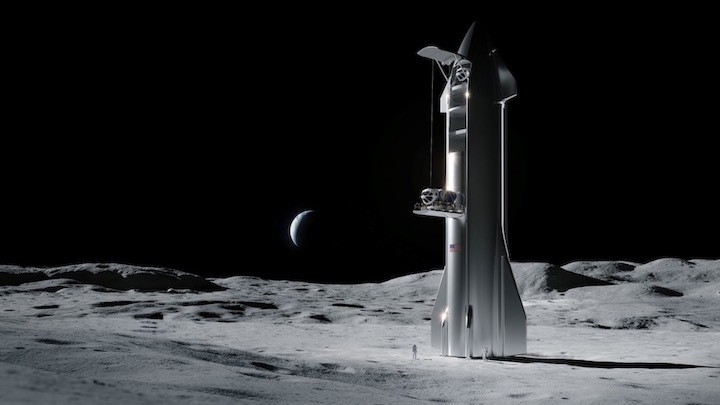
SpaceX is eligible to propose using its next-generation Starship vehicle to carry NASA robotic science payloads to the lunar surface, the U.S. space agency announced Monday, on missions that could precede future Starship flights with people on-board.
SpaceX is one of five companies NASA selected Monday to join a roster of commercial transportation providers to deliver scientific instruments and technology demonstration packages to the moon through the Commercial Lunar Payload Services, or CLPS, program.
“For CLPS, we offered the Starship and Super Heavy launch capability,” said Gwynne Shotwell, SpaceX’s president and chief operating officer. “That capability far exceeds the mass that CLPS was looking for, but we think that brings pretty extraordinary capability to NASA, both for the CLPS program and others. We can bring about 100 metric tons to the moon, and certainly return more.”
NASA requires the CLPS providers to be capable of delivering at least 22 pounds, or 10 kilograms, of payload mass to the moon.
SpaceX’s Starship and Super Heavy vehicles are the two main pieces of the company’s next-generation launch system. The combined launcher will stand 387 feet (118 meters) tall and measure 50 percent wider than the fuselage of a Boeing 747 jumbo jet.
Shotwell said SpaceX, founded and led by billionaire Elon Musk, aims to land a Starship on the moon in 2022. She said robotic Starship missions, such as flights contracted through NASA’s CLPS program, will pave the way for crewed Starship launches.
The Starship was “originally conceived to carry people,” Shotwell said, similar to the way SpaceX developed a cargo variant of the Dragon capsule before designing and building an upgraded human-rated Dragon spacecraft. “We’re leveraging NASA initially for cargo and science, so I think it’s a nice stepping stone and a nice path to getting comfortable with the technology … so that it’s reliable enough to put people on-board.”
SpaceX is building prototypes of the Starship vehicle in Texas and Florida, and atmospheric test flights could begin within weeks or months. The Starship will serve as a second stage on top of the Super Heavy booster, which SpaceX plans to build and test after the Starship.
The Super Heavy and Starship, both designed for reuse, will be powered by SpaceX’s methane-fueled Raptor rocket engines. SpaceX intends to land the Super Heavy on the ground similar to the way the company lands Falcon rocket boosters. The Starship will be similarly capable of vertical landings on Earth, or on other planetary surfaces.
“Starship, right now, (for) the early missions, we’re very focused on cargo, both satellite delivery to orbit, science delivery to the surface of the moon, m cargo and science to the surface of Mars,” she said. “Then we’ll be looking at some crew flights.”
The other companies selected by NASA to join the agency’s list of CLPS providers Monday were Blue Origin, Ceres Robotics, Sierra Nevada Corp. and Tyvak Nano-Satellite Systems. They join Astrobotic, Deep Space Systems, Draper, Firefly Aerospace, Intuitive Machines, Lockheed Martin, Masten Space Systems, Moon Express and Orbit Beyond, the nine companies selected as CLPS providers last year.
“We have a need and saw a need to bring on some additional providers that had enhanced lander capabilities,” said Steve Clarke, deputy associate administrator for exploration in NASA’s Science Mission Directorate. “This is based on … the agency’s objectives to get to the moon as soon as possible.”
Clarke said NASA received eight proposals to join the roster of CLPS providers. The agency picked five companies to “on-ramp” to the CLPS program.
“All of them bring to the table different strengths and different ideas, and that’s what we want to bring as NASA continues to lean forward and use commercial services to explore the moon,” Clarke said. “We want as many … diverse ideas as we can on the table. So we look forward to hearing reading and assessing those ideas when we put out these task orders.”
Blue Origin’s Blue Moon cargo lander can deliver nearly 8,000 pounds, or 3.6 metric tons, of payload equipment to the lunar surface. Brent Sherwood, Blue Origin’s senior vice president of advanced development programs, said Monday that the Blue Moon lander is designed to survive the two-week-long lunar night and can launch on the company’s New Glenn rocket.
John Roth, vice president of business development at Sierra Nevada’s space systems division, said the company will modify existing small satellite platforms for lunar lander missions to haul lighter payloads to the moon. Technologies developed for Sierra Nevada’s Dream Chaser space station cargo transporter could be used to carry heavier equipment to the lunar surface, Roth said.
The other companies’ initial lander designs are capable of carrying smaller payload packages to the moon.
Tyvak Nano-Satellite Systems specializes in building CubeSats and other small satellites, and Ceres Robotics is a Silicon Valley startup founded in 2017 to develop vehicles to explore the surfaces of the moon, Mars, asteroids and other planetary bodies.
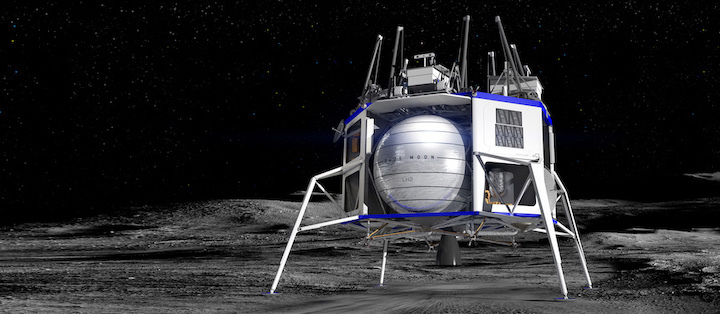
NASA started the CLPS program to purchase unpiloted rides to the moon for the agency’s scientific payloads aboard privately-owned spacecraft. The missions are precursors for future human expeditions to the moon planned in NASA’s Artemis program, which aims to return astronauts to the lunar surface by the end of 2024.
The 14 companies now part of the CLPS program are eligible to compete for NASA contracts to ferry scientific instruments to the moon. NASA is releasing a series of task orders for specific mission objectives, and the companies can submit bids for rights to conduct the missions.
“The services we are buying are buying, or are procuring, are end-to-end,” Clarke said. “The companies that we award task orders are responsible for securing a ride on a launch vehicle, and of course, delivering our instruments or payloads to the surface, and then actually enabling us to operate those instruments or payloads on the surface of the moon.”
NASA selected three companies — Astrobotic, Intuitive Machines and Orbit Beyond — for the first CLPS task orders in May. NASA terminated the task order with Orbit Beyond in July, but the company remains eligible for future CLPS contracts.
Astrobotic and Intuitive Machines remain on contract with NASA to deliver NASA science instruments to the moon’s surface in July 2021.
None of NASA’s 14 CLPS providers have a lunar lander currently in operation.
Firefly Aerospace’s CLPS proposal includes plans to build a U.S. version of the Israeli Beresheet lander, a privately-funded mission that crashed on the moon during a landing attempt in April.
In addition to its role in providing delivery services for NASA science payloads, the CLPS program will advance lunar landing technologies that could be useful on a future human-rated lander, according to NASA officials.
It’s also an experiment in the commercial procurement of lunar transportation services, an example NASA is following in the multibillion-dollar procurement of a human-rated lander for the Artemis program.
Blue Origin submitted a lander proposal derived from the Blue Moon spacecraft in response to NASA’s Human Landing System solicitation earlier this month. Boeing also confirmed it bid for an HLS contract.
Other companies, including SpaceX, are also expected to have submitted human-rated lander proposals.
Quelle: SN
----
Update: 21.11.2019
.
SpaceX Starship prototype blows its top
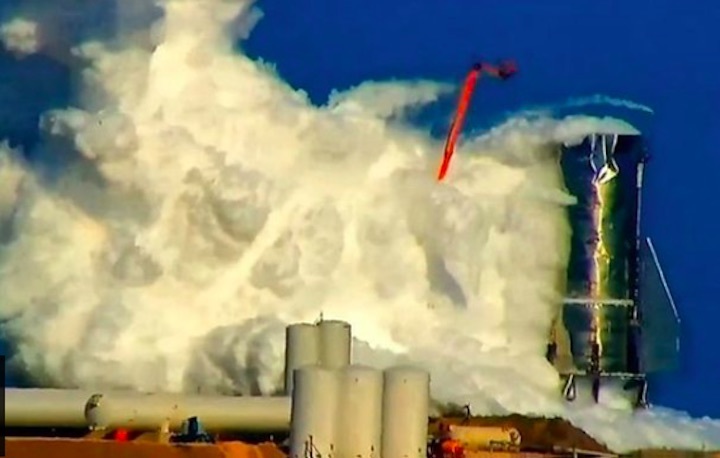
SpaceX's Starship rocket prototype experienced a major failure during pressurisation testing on Wednesday.
A video from the scene in Texas showed the top part of the vehicle rupture.
Cryogenic propellants that were being loaded at the time dispersed across the Boca Chica facility in a huge cloud.
The US company bills Starship as an all-purpose transportation system of the future. It will be used to ferry people and cargo off Earth, and to destinations around the globe.
The Mk-1 prototype was due to begin practice flights to an altitude of 20km in the coming weeks.
In a tweet, SpaceX CEO Elon Musk said that could no longer happen and the ship would be retired.
Development work is already being directed at another prototype, labelled the Mk-3.
"[Mk-1] had some value as a manufacturing pathfinder, but flight design is quite different," Mr Musk told his legion of fans on social media.
A statement issued by SpaceX read: "The purpose of today's test was to pressurise systems to the max, so the outcome was not completely unexpected."

Elon Musk has given regular updates on his plans for Starship, the most recent being in September when he spoke at length about the vehicle's engineering and its likely applications.
The Mk-3 vehicle, he said, could be built much more quickly than the Mk-1. It was also capable of going into orbit.
Like the SpaceX Falcon-9 rockets, Starship is designed to be reusable. More so, in fact.
On the Falcon-9, only the lower booster comes back to Earth after a flight; the upper-stage is expendable.
In the case of Starship, it and its booster, which is called the Super Heavy, will make a controlled landing following a mission.
Starship has been touted as a rival to the US space agency's (Nasa) big new rocket called the Space Launch System (SLS), which will be used to send astronauts to the Moon and Mars.
So far, Nasa is only considering Starship as a potential freighter, to deliver cargo to the lunar surface.
SpaceX has experienced a number of very public hardware mishaps in recent times. In April, for example, its Dragon astronaut capsule suffered a dramatic explosion on a test stand.
But the company is not afraid of these failures. It believes in a rapid process of "build, test and iterate".
SpaceX's methods - and successes - have had the rest of the rocket industry racing to catch up.
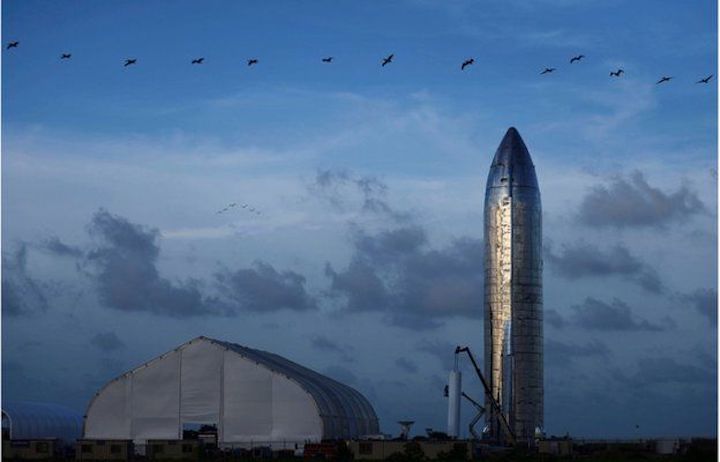
Quelle: BBC
+++
SpaceX’s first Starship prototype ruptures during cryogenic test
Video credit: @LabPadre / LabPadre on YouTube
SpaceX’s first partially-assembled Starship vehicle, originally built for atmospheric test flights, ruptured in dramatic fashion Wednesday during a cryogenic loading test at the company’s launch facility in South Texas.
The winged rocket appeared to blow its upper bulkhead while undergoing testing at SpaceX’s Boca Facility facility on the South Texas coast around 4:30 p.m. EST (3:30 p.m. CST; 2130 GMT) Wednesday.
A cloud of cryogenic fluid, possibly oxygen or nitrogen, erupted from the top of the vehicle, and video captured by nearby spectators appeared to show the upper tank bulkhead launching hundreds of feet into the air before falling to the ground near the Starship test stand.
The Starship vehicle remained largely intact after the accident, but some buckling was visible in its stainless steel skin.
“The purpose of today’s test was to pressurize systems to the max, so the outcome was not completely unexpected,” SpaceX said in a statement. “There were no injuries, nor is this a serious setback.”
But plans to fly the first full-size Starship vehicle, designed Mk1, on a test launch to an altitude of 65,000 feet (20 kilometers) have been shelved in favor of flying a future Starship rocket designed for orbital missions. In a press event at Boca Chica in September to update SpaceX’s Starship plans, Musk said the Starship Mk1 rocket — towering behind him on a Saturday night — would perform the atmospheric test flight.
The Starship is one of two components of SpaceX’s next-generation reusable launch system, which the company says will be the most powerful rocket ever built, capable of Future Starship vehicles will be joined with a Super Heavy booster, which SpaceX is also developing, to loft massive payloads into Earth orbit, to the moon, Mars and other deep space destinations.
In a tweet after Wednesday’s Starship mishap, SpaceX founder and chief executive Elon Musk said SpaceX is moving on to an modified version of the Starship, the first of which is known as the Starship Mk3.
“This had some value as a manufacturing pathfinder, but flight design is quite different,” Musk tweeted, referring to Mk1.
“The decision had already been made to not fly this test article and the team is focused on the Mk3 builds, which are designed for orbit,” SpaceX said in a statement.
A separate SpaceX team in Cocoa, Florida, is building the Starship Mk2 test vehicle. SpaceX is constructing a launch mount for the Starship at launch pad 39A at NASA’s Kennedy Space Center, hundreds of feet away from the location where the company launches Falcon 9 and Falcon Heavy rockets.
Wednesday’s statement from SpaceX raised questions about the company’s plans for the Starship Mk2, which was previously intended to travel via road and barge from Cocoa to pad 39A for ground checkouts and potential flight tests.
Since completing the initial build-up of the Starship Mk1 vehicle in September, SpaceX outfitted the rocket with internal structures and other hardware necessary to fill the vehicle with super-cold methane and liquid oxygen propellants. The methane and liquid oxygen will feed Starship’s Raptor engines.
Six Raptor engines will power the orbital-class version of the Starship. In September, Musk said three Raptors will fly on the Starship for low-altitude tests, and up to 37 Raptor engines will power the Super Heavy booster.
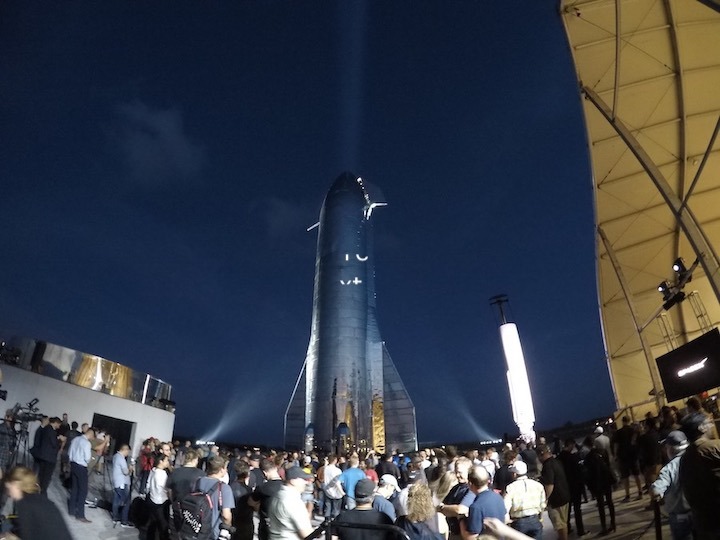
The privately-developed Starship vehicle stands around 164 feet (50 meters) tall with its nose cone installed. The nose cone, which includes aerodynamic fins, was not on the rocket for Wednesday’s test. The vehicle measures around 30 feet (9 meters) in diameter, about one-and-a-half times the diameter of a Boeing 747 jumbo jet.
Combined with the Super Heavy first stage, the entire stack will stand around 387 feet (118 meters) tall.
The fully reusable Super Heavy/Starship launch vehicle will be able to loft some 150 tons of payload to low Earth orbit, according to Musk. The Starship serves as the upper stage of the combined vehicle, and SpaceX says it will introduce an in-space refueling capability to allow Starships to ferry heavy payloads into deep space.
Both stages will be reusable, returning to Earth for vertical propulsive landings similar to SpaceX’s Falcon rocket boosters. SpaceX only recovers the first stage on its Falcon rocket family.
The Starship will eventually replace the Falcon family of rockets, hauling satellites into orbit and delivering cargo and crews to the moon and Mars, according to SpaceX.
On Monday, NASA announced SpaceX is one of five companies joining the agency’s commercial lunar lander program. SpaceX’s Starship is one of NASA’s options to deliver experiments and cargo to the moon’s surface ahead of a planned human lunar expedition in 2024.
Gwynne Shotwell, SpaceX’s president and chief operating officer, said Monday that the company aims to land a Starship on the moon in 2022 without humans on-board. A crewed Starship flight will come some time later, Shotwell said.
Quelle: SN
